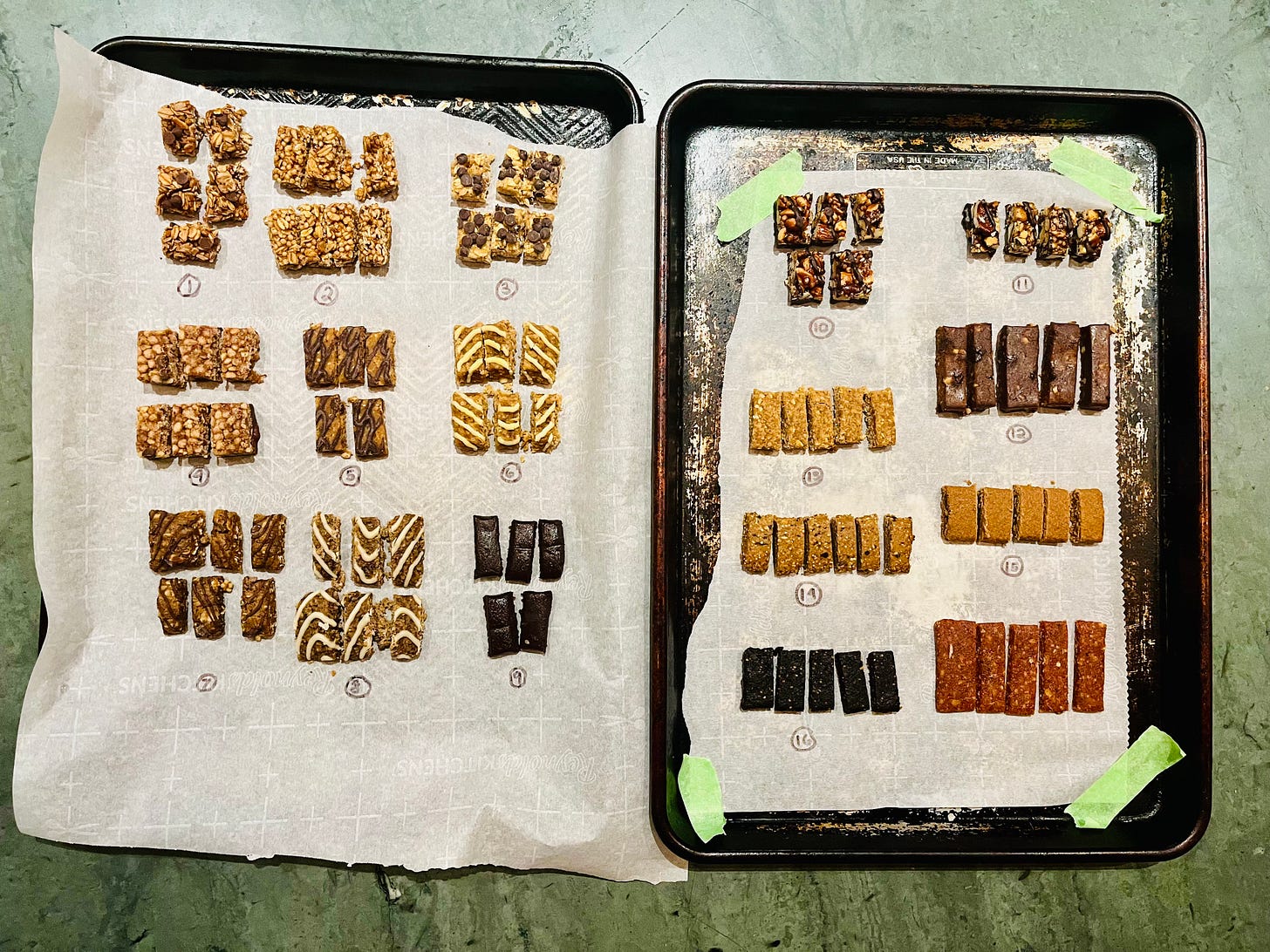Since many of our founding subscribers here at Consumed started off as Pressure Cooker listeners, Jane and I decided to devote our very first buying guide to an item that holds a special place in the hearts – and cabinets – of parents everywhere: snack bars.
There are a zillion snack bars on the market, and it’s no mystery why. For parents, they’re something handheld and shelf-stable that can be packed in a lunchbox or tucked into a pocket in case of hanger emergencies (I, for one, have had a granola bar floating around in my handbag continuously since 2018). For kids, the dessert-inspired flavors and colorful packaging make them more exciting than the plain old string cheese or cut veggies that parents might otherwise offer. And for food brands, at as much as $2 a pop, bars are typically a solid moneymaker.
What we found in evaluating over four dozen options is that, when it comes to quality and taste, snack bars are all over the map. Some are actually pretty great! Some are terrible! And where various brands fell along that spectrum surprised us. Here are are top picks.
BEST OVERALL:
Comes in: Almost two dozen flavors
Price: $17 for 12 from Amazon
Why we like them: Though they’re marketed towards adults, not kids, we think these fruit-and-nut-based bars beat kid-oriented options in both flavor and nutrition. They’re less processed than nearly all the competition, with more fiber and more protein. KIND bars are available in a wide enough array of flavors to satisfy different tastes (and keep kids from getting bored of them), and because they come in multiple sizes – the original full size bar, plus KIND Minis and KIND Thins – they cater to different ages and hunger levels.
RUNNERS UP:
Comes in: Chocolate Chip, Mixed Berry, Cookies & Cream, and Banana
Price: $4.49 for 6 from Target
Why we like them: If it’s a classic granola bar you’re after, this one has slightly less sugar and fewer additives than options from Nature’s Valley, Quaker, Cascadian Farm, or Annie’s. It’s the unique addition of vegetable extracts that really sets MadeGood apart, making these bars a solid source of several vitamins, too.
Comes in: Chocolate Chip, Chocolate Mint, Cookies n’ Cream, Cinnamon Crunch
Price: $15 for 15 from Amazon
Why we like it: Our kid and adult tasters loved this bar’s pleasing chewy texture and sweet-but-not-cloying flavor. These bars do have a long ingredient list, and it’s a fair criticism that they’re as much ‘dessert’ as ‘snack,’ but we think they’re a good choice for a kid who needs a nut-free option that’s still substantial enough to get them through an active afternoon; this bar has as much protein as a full-sized KIND bar.
Wipala Kids Organic Fruity Bars
Comes in: Goldenberry & Broccoli, Mango & Kale, Strawberry & Spinach
Price: $20 for 12 from Amazon
Why we like it: Basically beefed up fruit leather, these bars are tangy, bright, and made from organic fruits, organic veggies and organic quinoa: that’s it. With fewer calories than our other picks, they might not be enough to fill up older or more active kids – and, at more than $1.50 each, they are on the pricier side. But the flavor is great, and you’d be hard-pressed to find a more nutrient-dense packaged snack, or a more pristine ingredient list.
The Hunt
To compile this buying guide, I scoured my local grocery and convenience stores, talked to friends about what they buy, and searched online. I cast a wide net, including not just snack bars marketed specifically to kids, but ones aimed at a general audience, too. I wound up with a list of 49 snack bars – that’s not counting the multiple flavors that most of these products are sold in.
When it comes to snack bars overall, the bad news is that they are, with few exceptions, highly processed; agglomerations of syrups and pastes and vegetable oils, molded into a tidy rectangle. The jury is still out on whether highly processed foods are ipso facto bad for you, or whether it comes down to the merits of each individual ingredient. But a growing number of nutrition experts believe that you’re better off avoiding ultra-processed foods when you can.
That said, we are pragmatists, and the need for shelf-stable, on-the-go items for kids is real. The good news about the snack bars on the market today is that while most have lengthy ingredient lists, very few contain additives that are viewed as specifically concerning, such as preservatives or synthetic food dyes.
Processing aside, the main issue with snack bars is that most have too much sugar and not enough fiber or protein. That means they won’t do a good job of keeping a kid full until their next meal. That is certainly the case with the Quaker Chewy Granola Bars that I was raised on: with just 1 gram of protein and 1 gram of fiber per bar, they are essentially just a block of refined carbs.
Maybe not so surprising for a product that boasts “real chocolate chips!” on the label?
But some options that seem quite wholesome on the surface are also sugar monsters. For instance: I’ve been buying Nature’s Bakery Raspberry Fig Bars every week for years, my rationale being that…fruit!! But in doing this research I discovered that one serving contains 19 grams of sugar – the most of any bar I came across, and roughly the same as a Snickers – with a host of chemical texturizers. These bars are now dead to me!
Anyway: Once we eliminated options on the basis of nutritional or additive concerns, we ended up with 17 bars that were blind tested by kids and adults. We were surprised by how many had flavors that were off or unappealing, and/or textures that were disappointingly crumbly, waxy, or dry.
The Smart Choice
There’s a lot that we love about our top pick, KIND Bars. The chocolate drizzle made them look decadent to our kid testers, when in fact they contain less sugar, and more fiber and protein, than almost any other option (exact quantities vary by flavor; the dark chocolate nuts & sea salt is a great choice, with 5 g sugar, 6 g protein, and 7 g fiber). KIND bars are also made primarily from whole foods – nuts and fruit – and thus less processed than other options. Finally, we love that these bars require real chewing; in a world of soft foods, that not only forces kids to slow down as they eat, but it’s great for their jaw development.
Of course, many kids need a nut-free bar to bring to school or sports, or they don’t like nuts, or they are too young to safely eat them. So we recommended three other bars that we think taste great, pass nutritional muster, and offer a range of different flavor profiles.
We chose MadeGood Organic Granola Bars as our favorite classic granola bar; Clif Kid ZBar Protein for a high-protein snack bar that is also nut-free; and Wipala Kids Organic Fruity Bars as a delicious and highly nutritious fruit-based bar, especially great for a light snack.
A Word About Toddler Bars
Most of the major baby food brands now produce soft whole-grain snack bars. They differ from mainstream kids’ snack bars in that they’re usually smaller – under an ounce, and under 100 calories – and instead of flavors like chocolate cookie dough and cinnamon bun, they come in pumpkin & banana or apples & spinach (a sure sign these brands are marketing to the parents, not yet the kids!).
We included several in our taste test, but found them to be dry and cardboardy to the point of being inedible; plus, they are highly processed, often with a number of additives. Plum Organics’ Mighty Snack Bars, for instance, contain emulsifiers and texturizing agents, and the Soft Baked Bars made by fancy baby food darling Once Upon a Farm contain 12 grams of sugar. Save your money!
The Fine Print
Our buying guides are much more than taste tests. We try to balance nutrition, environmental pros and cons, price, and taste. Click here to learn more about our philosophy and selection process.
What we included in this buying guide:
49 widely available snack bars, including:
Toddler bars: Cerebelly, Earth’s Best, Happy Family, Little Spoon, Once Upon a Farm, Plum Organics, Sprout Organic, Yumi
Kids’ bars: Annie’s, Clif (ZBar), GoMacro Kids, Junkless, KIND Kids, MadeGood, Power Crunch, Skout, Wipala Kids, Dino Bars
Adult/general audience bars: Bobo’s, Cascadian Farm, Clif, Clif Luna Bar, Dave’s Killer, JonesBar, Kellogg’s Nutri-Grain, KIND, Kodiak, LaraBar, Nature’s Bakery, Nature’s Valley, Quaker, Rx, Simple Mills, That’s It
What we didn’t include:
Boutique offerings: We came across a few bars produced by startup brands in the course of internet research that we were unable to locate IRL. If we couldn’t find it in visits to multiple local retailers – or order it easily online for fast and free delivery – we did not include it.
Store (a.k.a. private label) brands: There are a few private label snack bars sold by retailers like Trader Joe’s and Target (Good & Gather). Since these products are only available by visiting a single retailer, we did not include them.
Adult protein bars: High-calorie bars aimed at athletes, or claiming to be a meal replacement, were not included.
What we prioritized:
Low(er) sugar: snack bars, as a category, are relatively high in sugar. We looked for bars that had less than 10 grams of sugar.
Higher protein: Most kids’ bars have very little protein; we liked to see at least 3 grams per serving.
Higher fiber: As with protein, snack bars in general lack fiber. We looked for products with 2 or more grams per serving.
Minimal additives, and no additives of concern: We eliminated any bars with ingredients classified as additives of concern by the Environmental Working Group, and prioritized bars without additives.
Organic: Arguably less important for your snack bar than your fruits and vegetables, but we think that organic products are always worth choosing, if you can afford the added cost.











